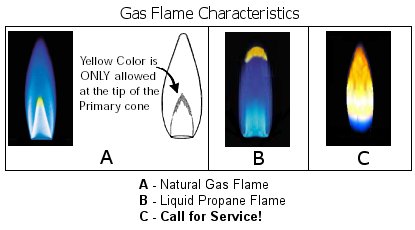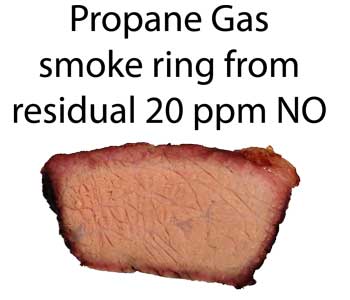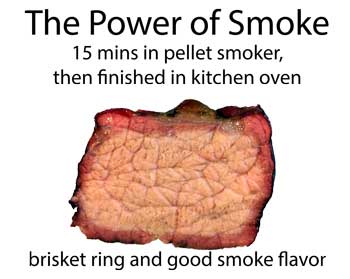| g e n u i n e i d e a s | ||||||
 |
 |
 |
 |
 |
 |
 |
| home | art and science |
writings | biography | food | inventions | search |
| gas fuel | ||
|
||
|
May 2014 Gas Fuel Summary:
Properly maintained, gas flames are excellent heat sources. Whether purchased at the home center in a 20 lb tank, or piped into your backyard, gas is a clean-burning and cost-efficient fuel. One twist of the knob, and heat output is quickly modulated by a factor of ten. No waiting for wood to ignite, and no ash to clean up. Almost every bit of stored chemical energy is released in combustion, with very little waste. No wonder gas grills now make up 60% of the market. The majority of fuel tanks are filled with propane, while underground supplies are pressurized with natural gas (methane). A tiny bit of a pungent chemical odorant containing sulfur is added to these fuels so you can detect a leak with a single sniff. When mixed with oxygen from the surrounding air in just the right ratio, these gases are entirely consumed in a flame, liberating only water and carbon dioxide as waste products1. Even the "rotten egg" mercaptan odorant molecules are destroyed by combustion. So gas generates heat without flavor or danger. Just like an electric heater, with one key difference.
The secret to complete combustion is oxygen, in just the right proportion to the fuel. About 20:1 for air:propane, and 10:1 for air:methane. Fuel jets and venturis are designed to maintain this ratio, but may become clogged or jarred, or the gas pressure may droop. If oxygen levels diverge too much from this ratio, rather than inert carbon dioxide, some poisonous carbon monoxide molecules are formed. And you don't want to breath low levels of carbon monoxide (CO) for very long. It displaces oxygen from hemoglobin so tenaciously, the low levels accumulate to a critical tipping point, until you suffocate in your own blood. CO poisoning claims 400 victims a year, and injures tens of thousands. Many suffer life-long neurological impairments. As we will see in a moment, ventilation is the key to efficient gas combustion. Measurements performed in actual homes sadly confirms the average kitchen gas burner operates outside ideal conditions, and actually produces small levels of CO/NOx. In our kitchen, I measured the ratio of CO2 to CO emissions to be a factor of 1000x. In other words, almost perfect combustion. But "near perfect" is still imperfect, and left 20 ppm of CO flowing out of the flames just six inches above the burner, along with 10 ppm of nitric oxide. When you cook on the stove, the frying pan blocks some of the combustion air from reaching the flame, and the CO levels rise by another factor of three. Depending on kitchen ventilation, these small levels can accumulate, exposing people to levels 2-5x higher than considered safe in the workplace. The barbecue smoke ring is a record of absorbed CO/NO gases stabilizing the red meat myoglobin molecule against turning gray from heat damage. If you bake a pork tenderloin in the kitchen oven and it emerges with a bright red "smoke" ring, leave the house immediately and call the fire department. Something is likely wrong with your stove or vents. Yet another good reason to cook outdoors.. Gas flames are perfect for grilling, especially since most gas grills protect the gas nozzles with a metal flare-up shield. This plate catches grease and singes the drippings into an aromatic plume that rises up and coats the meat. But that's not classic barbecue, with its heady aroma of burning wood. Luckily, the absent smoke flavor is easily recovered- most gas smokers are designed with a tray to hold wood chips or sawdust above the flames. Or, a perforated box is placed directly on a backyard gas grill, turning it into an improvised smoker. Gas flames cause the wood to smolder and then catch fire, so wood combustion products flavor your meat, not propane or methane. Sadly, a few smoke trays are mere afterthoughts, with the wood smoldering and puffing out impressive clouds of acrid white smoke, never properly combusting. Especially if the wood is trying to burn in "downstream" air that was already turned into carbon dioxide by the gas flame! But some gas smokers have their own dedicated vents for the wood tray, and most do their job well. I've measured the residual impurity levels in a gas smoker. Without adding wood, carbon monoxide is typically less than 20 ppm. And nitric oxide is also less than 20 ppm- but still enough to created a weak smoke ring:
Adding wood raised the CO levels by a factor of 10 and contributed great smoke flavor, but the poor combustion conditions did not increase nitric oxide levels, even though the wood is full of nitrogen. So the smoke ring is mostly a result of the high temperature propane flame converting one out of every 25,000 nitrogen air molecules into NO gas. Some gas smokers run at even lower flame temperatures, and the NO levels are so reduced, there is often no smoke ring at all. In a well-oxygenated gas smoker where nitric oxide IS produced from wood chip combustion, what is the minimum amount of wood necessary to generate a classic smoke ring? Assuming the smoke ring contains 50 ppm of nitric oxide, and the ring takes up 10% of the meat's volume, and wood contains 0.25% (2500 ppm) nitrogen, and all of the smoke ends up being absorbed by the food, you need 50 ppm/10/2500 ppm=1/500th the weight of the meat. Or about a third of an ounce for a 10 lb brisket. In reality, the meat blocks at most 10% of the smoker chamber's volume, and some smoke that impinges on the meat does not stick. I estimate less than 5% of the smoke is actually absorbed, so the answer is closer to 6 oz of wood or charcoal. Thus very little smoke is necessary, especially since our nose and tongue can detect flavors below the part per billion level. For example, I placed a cold, raw brisket in a pellet smoker generating 30 ppm of NO for just 15 minutes. Then removed from the smoker and finished cooking in an electric kitchen oven. Not only was there a smoke ring, but a nice light smoke flavor! Around an ounce of pellets were burned during the 15 minutes:
These combined gas/wood smokers are very popular with restaurants because they require no baby sitting and can be set to run themselves on automatic over night. In fact, some surveys indicate the vast majority of old-time wood-pit restaurants have converted to gas- despite the piles of cordwood stacked near their front doors. They are less expensive to operate than wood, you never run out of food, and the customers don't seem to notice. Barbecue enthusiasts claim they can tell the difference, and have a point, but the results are credible, and a slathering of sauce covers most sins... They are also popular with a growing number of backyard cooks:
There are a few poorly designed commercial units on the market which starve the wood box for oxygen, and far too many sketchy home-brew gas smokers with inadequate air flow kicking around. You can understand why- the gas flame is very hot, but low and slow barbecue means low temperature cooking. So many people cut down on the air flow by adjusting the venturi, or just cracking open the propane valve. Wind can suck air out of the feed vents, starving the flames. Leading to carbon monoxide production or an explosion. Carbon monoxide exposure will be minimized by dilution with passing breezes, but an explosion is a good cook, ruined. How much air is enough? ASHRAE (the American Society of Heating, Refrigerating and Air Conditioning Engineers) recommends a minimum of 100 cfm (cubic feet a minute) in the kitchen when cooking. Most older homes leak this much air through gaps in the wall and windows, so no external ventilation was required. But in today's tightly insulated homes, engineered vent systems are prudent and usually required by code2. In fact, best-practices suggest drawing the 100 cfm directly from outside, so you don't squander conditioned room air on the stove. More generally, to be confident the carbon and hydrogen atoms in propane and methane have enough oxygen to completely burn and for the house stay below EPA guidelines, a good rule of thumb is 1 m3/s airflow for every 100kw of burner power (or more familiarly in the US, 1 cfm for every 100 BTU/hr). A high-end kitchen stove might be rated at 15,000 BTU/hr/burner, or 60,000 BTU/hr total, which demands 60,000 BTU/100 BTU/cfm=600 cfm when running flat out. In other words, a large externally vented fan! Outdoors, you need less air going THROUGH the grill because any poisonous exhaust fumes are diluted by fresh air on the patio. Assuring proper combustion is the key, and gas grills combine a long air vent on one edge with a loose fitting lid to make sure there is adequate combustion air. A 30,000 BTU/hr propane grill demands around 300 cf/hr of airflow3. That same grill might have a volume of 6 ft3, so it exchanges all of its air 50 times an hour. But most grills are designed to supply "excess" air, and I've measured some at 150 air exchanges an hour. This high airflow makes it very difficult to maintain high humidity levels on a grill fitted with a smoke box, or even in a specialized gas smoker. But it is possible, though a large water pan is prudent4. On the other hand, depending on the cleverness of the smoker design, this high air flow rate may offer a positive side effect, by optimizing wood combustion conditions, so the smoke is clean, pure and sweet. You may find it difficult to get "enough" smoke flavor on some gas grills- between high airflow and odd wind current patterns in the smoke chamber, the meat may encounter fewer aromatic chemicals than desired. More likely in a dedicated gas smoker. The three keys to a successful gas smoker design are:
Under the best conditions, food cooked in a gas smoker can taste nearly as great as in a traditional stick burner.
|
||
|
1 Natural gas is mostly methane, CH4. When methane burns, each CH4 molecule combines with two 02 molecules to make two H2O molecules and one CO2 molecule: CH4+2O2→ 2H2O+CO2 So (remembering high school chemistry and converting moles to weight), when your oven or grill burns 1 pound of methane it consumes 4 lbs of oxygen, producing 2.25 pounds of water and 2.75 pounds of CO2, plus a few trace elements like sulfur, which are naturally present in the gas On a propane grill, the formula is C3H8. Each molecule of propane combines with five oxygen molecules, to produce three CO2 and four H2O. C3H8+5O2→ 4H2O+3CO2 When burned in air, one pound of propane consumes 3.6 lbs of oxygen to produce 1.6 pounds of water and 3 pounds of CO2. If you are interested in your carbon footprint, one propane tank contains 20 lbs of gas. But taking the 15 lbs number as realistic (you never fully empty the tank), then 15 lbs of propane produces 45 lbs of CO2. According to the EPA, the average car emits ~400 gms CO2 per mile, or 0.88 lbs. So a tank of propane emits the same amount of CO2 as driving 50 miles.
2 The "Vent Free" industry association has successfully lobbied for vent-free heater and fireplace zoning, arguing the CO and moisture issues are minor except in a few cases. They are correct in principle, but in practice installers are not alway competent, and homeowners make innocent changes to their house that can dramatically effect air flow and safety for previously constructed vent-free units. You should only enjoy a vent-free fire if you install an accurate and reliable CO monitor in the same room. 3 There are around 90,000 BTU in a gallon of propane. Each gallon of liquid propane can expand to 36 cu ft if released. And each cu ft of propane requires around 24 cuft of air to completely combust. So 90,000 BTUs of propane requires a minimum (given some slop for inefficiencies) of ~ 900 cu ft of air for proper combustion. Or, on an hourly basis, 10,000 BTU/hr requires 100 cuft/hr of combustion air. Or 1 cuft/hr for 100 BTU/hr, which is 60 times less than ASHRE recommendation for interior ventilation. 4 How humid is the air in a gas grill or gas smoker? The answer depends on air flow. Combusting propane produces water, but the humidity level is diluted by air, which is 80% nitrogen. So the actual chemical reaction is (20N2+5O2)air + (C3H8)propane→ 20N2+4H2O+3CO2 Or 4/(20+4+3)=15% by mole. But actual gas grills deliver an "excess" amount of air to the combustion chamber. Typically a factor of two or more air than absolutely necessary to burn propane. So closer to 3-5% mole, which on a relative humidity basis (at 225F) is also around 5% RH. For example, a 5000 BTU/hr gas cabinet smoker burns around 5000 BTU/21000 BTU/lb of propane in energy= 1/4 lb of propane per hour, producing 1.6 lbs water per lb of propane*.25 lbs~ 1/2 lb of water. During the same hour you might have cooked 20lbs of meat that will lose 25% of its weight over 10 hrs, or another half pound of water in an hour. Together, given realistic air leaks, they might raise the RH in the smoke chamber to 8% or so. Not bad, but not really enough to keep meat moist. By way of comparison, a water tray in a cabinet or even pellet smoker will raise the relative humidity level to 15%.
|
||
Contact Greg Blonder by email here - Modified Genuine Ideas, LLC. |



